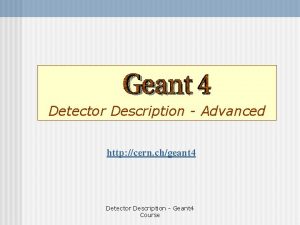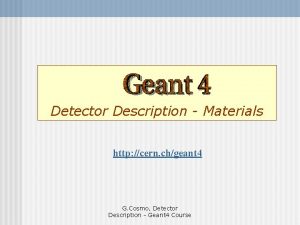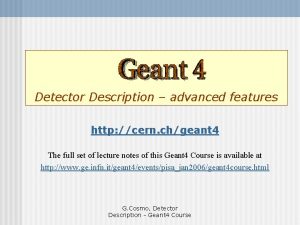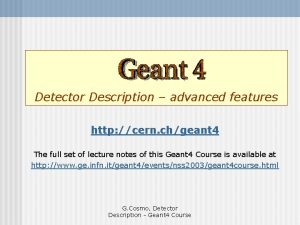Detector Description Materials http cern chgeant 4 The














- Slides: 14

Detector Description - Materials http: //cern. ch/geant 4 The full set of lecture notes of this Geant 4 Course is available at http: //www. ge. infn. it/geant 4/events/nss 2003/geant 4 course. html G. Cosmo, Detector Description - Geant 4 Course

Materials - The System of units & constants Definition of elements Materials and mixtures Some examples … G. Cosmo, Detector Description - Geant 4 Course

Unit system n Geant 4 has no default unit. To give a number, unit must be “multiplied” to the number. n for example : G 4 double width = 12. 5*m; G 4 double density = 2. 7*g/cm 3; n n n If no unit is specified, the internal G 4 unit will be used, but this is discouraged ! Almost all commonly used units are available. The user can define new units. Refer to CLHEP: System. Of. Units. h Divide a variable by a unit you want to get. G 4 cout << d. E / Me. V << “ (Me. V)” << G 4 endl; G. Cosmo, Detector Description - Geant 4 Course 3

System of Units n System of units are defined in CLHEP, based on: n n n millimetre (mm), nanosecond (ns), Mega e. V (Me. V), positron charge (eplus) degree Kelvin (kelvin), the amount of substance (mole), luminous intensity (candela), radian (radian), steradian (steradian) All other units are computed from the basic ones. In output, Geant 4 can choose the most appropriate unit to use. Just specify the category for the data (Length, Time, Energy, etc…): G 4 cout << G 4 Best. Unit(Step. Size, “Length”); Step. Size will be printed in km, m, mm or … fermi, depending on its value G. Cosmo, Detector Description - Geant 4 Course 4

Defining new units n New units can be defined directly as constants, or (suggested way) via G 4 Unit. Definition. n n Example (mass thickness): n n n G 4 Unit. Definition ( name, symbol, category, value ) G 4 Unit. Definition (“grammpercm 2”, “g/cm 2”, “Mass. Thickness”, g/cm 2); The new category “Mass. Thickness” will be registered in the kernel in G 4 Units. Table To print the list of units: n n From the code G 4 Unit. Definition: : Print. Units. Table(); At run-time, as UI command: Idle> /units/list G. Cosmo, Detector Description - Geant 4 Course 5

Definition of Materials n Different kinds of materials can be defined: n n n isotopes elements molecules compounds <> G 4 Isotope <> G 4 Element <> G 4 Material and mixtures <> G 4 Material Attributes associated: n temperature, pressure, state, density G. Cosmo, Detector Description - Geant 4 Course 6

Isotopes, Elements and Materials n G 4 Isotope and G 4 Element describe the properties of the atoms: n n n Atomic number, number of nucleons, mass of a mole, shell energies Cross-sections per atoms, etc… G 4 Material describes the macroscopic properties of the matter: n n temperature, pressure, state, density Radiation length, absorption length, etc… G. Cosmo, Detector Description - Geant 4 Course 7

Elements & Isotopes n Isotopes can be assembled into elements G 4 Isotope (const G 4 String& G 4 int G 4 double n name, z, // number of atoms n, // number of nucleons a ); // mass of mole … building elements as follows: G 4 Element (const G 4 String& name, const G 4 String& symbol, // element symbol G 4 int n. Iso ); // # of isotopes G 4 Element: : Add. Isotope(G 4 Isotope* iso, // isotope G 4 double rel. Abund); // fraction of atoms // per volume G. Cosmo, Detector Description - Geant 4 Course 8

Material of one element n Single element material G 4 double density = 1. 390*g/cm 3; G 4 double a = 39. 95*g/mole; G 4 Material* l. Ar = new G 4 Material("liquid. Argon", z=18. , a, density); n Prefer low-density material to vacuum G. Cosmo, Detector Description - Geant 4 Course 9

Material: molecule n A Molecule is made of several elements (composition by number of atoms): a = 1. 01*g/mole; G 4 Element* el. H = new G 4 Element("Hydrogen", symbol="H", z=1. , a); a = 16. 00*g/mole; G 4 Element* el. O = new G 4 Element("Oxygen", symbol="O", z=8. , a); density = 1. 000*g/cm 3; G 4 Material* H 2 O = new G 4 Material("Water", density, ncomp=2); H 2 O->Add. Element(el. H, natoms=2); H 2 O->Add. Element(el. O, natoms=1); G. Cosmo, Detector Description - Geant 4 Course 10

Material: compound n Compound: composition by fraction of mass a = 14. 01*g/mole; G 4 Element* el. N = new G 4 Element(name="Nitrogen", symbol="N", z= 7. , a); a = 16. 00*g/mole; G 4 Element* el. O = new G 4 Element(name="Oxygen", symbol="O", z= 8. , a); density = 1. 290*mg/cm 3; G 4 Material* Air = new G 4 Material(name="Air", density, ncomponents=2); Air->Add. Element(el. N, 70. 0*per. Cent); Air->Add. Element(el. O, 30. 0*per. Cent); G. Cosmo, Detector Description - Geant 4 Course 11

Material: mixture n Composition of compound materials G 4 Element* el. C = …; G 4 Material* Si. O 2 = …; G 4 Material* H 2 O = …; // define “carbon” element // define “quartz” material // define “water” material density = 0. 200*g/cm 3; G 4 Material* Aerog = new G 4 Material("Aerogel", density, ncomponents=3); Aerog->Add. Material(Si. O 2, fractionmass=62. 5*per. Cent); Aerog->Add. Material(H 2 O , fractionmass=37. 4*per. Cent); Aerog->Add. Element (el. C , fractionmass= 0. 1*per. Cent); G. Cosmo, Detector Description - Geant 4 Course 12

Example: gas n It may be necessary to specify temperature and pressure n (d. E/dx computation affected) G 4 double density = 27. *mg/cm 3; G 4 double temperature = 325. *kelvin; G 4 double pressure = 50. *atmosphere; G 4 Material* CO 2 = new G 4 Material(“Carbonic. Gas", density, ncomponents=2 k. State. Gas, temperature, pressure); CO 2 ->Add. Element(C, natoms = 1); CO 2 ->Add. Element(O, natoms = 2); G. Cosmo, Detector Description - Geant 4 Course 13

Example: vacuum n Absolute vacuum does not exist. It is a gas at very low density ! n Cannot define materials composed of multiple elements through Z or A, or with r = 0. G 4 double atomic. Number = 1. ; G 4 double mass. Of. Mole = 1. 008*g/mole; G 4 double density = 1. e-25*g/cm 3; G 4 double temperature = 2. 73*kelvin; G 4 double pressure = 3. e-18*pascal; G 4 Material* Vacuum = new G 4 Material(“inter. Galactic", atomic. Number, mass. Of. Mole, density, k. State. Gas, temperature, pressure); G. Cosmo, Detector Description - Geant 4 Course 14
 Go noodle cant stop the feeling
Go noodle cant stop the feeling What is useful materials
What is useful materials Natural materials and man made materials
Natural materials and man made materials What is adopting materials
What is adopting materials Direct materials budget with multiple materials
Direct materials budget with multiple materials Licenseid=string&content=string&/paramsxml=string
Licenseid=string&content=string&/paramsxml=string Http //mbs.meb.gov.tr/ http //www.alantercihleri.com
Http //mbs.meb.gov.tr/ http //www.alantercihleri.com Http //pelatihan tik.ung.ac.id
Http //pelatihan tik.ung.ac.id Hình ảnh bộ gõ cơ thể búng tay
Hình ảnh bộ gõ cơ thể búng tay Bổ thể
Bổ thể Tỉ lệ cơ thể trẻ em
Tỉ lệ cơ thể trẻ em Gấu đi như thế nào
Gấu đi như thế nào Thang điểm glasgow
Thang điểm glasgow Hát lên người ơi alleluia
Hát lên người ơi alleluia


























